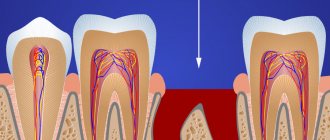If you are planning an implantation or removal of a cyst, be prepared for the fact that the dentist will have to cut into the gum. When an unerupted or incompletely erupted wisdom tooth is removed from the gums, an incision is also inevitable.
After surgery, complications such as swelling, bleeding, and aching pain are possible. The reasons include decreased immunity, infection in the mouth, or improper care during the postoperative period. Therefore, the best thing you can do is to remember and follow all the doctor’s recommendations.
Why did gumboil appear after dental treatment?
Swelling of the gums indicates the occurrence of an inflammatory process, which caused the complication. If painful sensations are observed against the background of the tumor, the main reasons for this may be:
- Periodontal inflammation. The tumor is observed on both cheeks, but pronounced swelling occurs only on the infected side.
- Neglected teeth, improper placement of fillings. Before swelling occurs, pain occurs. After 2-3 days, a flux with pus may form.
- Incorrect development of wisdom teeth. A hood forms from the mucous membrane, in which food particles accumulate and become inflamed.
- Removal of a tooth. Due to mechanical damage to the tissue, swelling can be considered normal.
- Cyst. The inflammatory process lasts for 1.5-2 years and injures the periosteum. The pathology occurs against a background of severe pain.
Attention! Swelling of the cheek after dental treatment can develop due to infection in the socket, which not only causes discomfort and swelling, but can also lead to more serious consequences.
If there is no pain during swelling, the reasons for this are as follows:
- allergic reaction to anesthesia, dental materials (swelling sometimes affects the entire face);
- removal of the nerve: part of the nerve may remain in the canals; after installation of the filling, flux appears;
- dissection of the gums, extracted tooth (in these cases, swelling is normal);
- infectious inflammation of the lymph in children, accompanied by aches and fever;
- neurological diseases accompanied by swelling, congestion in the ears, sore throat, weakness.
Important! In the case of severe pathologies of internal organs, the drainage of fluid is often disrupted; as a result, it accumulates in the nose, cheeks, neck, cheekbones and near the eyes.
General recommendations for prevention
To avoid the development of serious complications, you need to:
- In the first 1.5-2 days after implantation, apply ice to the operated area . This is especially important when a sinus lift has been performed or 2 or more implants have been installed. Compresses are performed several times a day by applying cold to the face for 20-30 minutes. Helps reduce pain and relieve swelling.
- For a week after surgery, sleep on a high pillow . This accelerates the outflow of blood from the damaged area and eliminates swelling. You should try not to lie on the operated side.
- In the initial period, you need to eat only food at room temperature. It should be liquid, semi-liquid or crushed in a blender. It is necessary to completely eliminate too spicy and salty foods.
- After eating, be sure to strip with antiseptic solutions. This can be Betadine (10%) or Chlorhexidine, which will prevent suppuration of the wound and relieve swelling.
- Use a soft brush to brush your teeth . Avoid the suture area; treat the wound with cotton swabs soaked in a 3% hydrogen peroxide solution.
- The inflammatory process will be prevented by dental paste or adhesive ointment “Solcoseryl” , which after rinsing should be applied in a thick layer to the operated area. The substances contained in the composition will accelerate tissue regeneration and reduce discomfort caused by the tips of synthetic threads on the seams.
Worth avoiding:
- stress;
- physical activity;
- flights;
- sudden temperature changes (including visiting a sauna or bathhouse).
What does flux look like?
It is of infectious origin, the process occurs against the background of inflammation of the body of the jaw or in the periosteum. Flux is formed not only after dental surgery, but also after furunculosis or tonsillitis. If the cheek and gums are swollen, there is throbbing or mild pain, in advanced stages pus may appear and the temperature may rise. On the upper jaw, the flux covers the lip, cheek, gum and nasolabial area. In addition to the face, the infection often spreads to the neck.
Anti-inflammatory and antibacterial drugs are used for treatment. After using topical medications, you should not eat or drink liquids for 2 hours.
Swelling on the inside of the cheek
Anesthesia makes tooth extraction easier. But, if after treatment of a tooth your cheek is swollen, you should find out the origin of the pathology. You may need treatment for your gums. Discomfort appears in many patients after depulpation. Pain and swelling on the inside of the cheek can be observed from 2 hours to 7 days. If discomfort intensifies or occurs 2 days after surgery, you should immediately consult a dentist.
If, after removing the nerve, in addition to painful sensations, the gums become inflamed, purulent discharge appears, and the temperature rises, you should visit a dentist. He will find out why the cheek is swollen and how to remove the gumboil.
Attention! You cannot take painkillers and anti-inflammatory drugs before consulting a doctor; this will complicate the diagnosis, which will not allow you to prescribe adequate treatment.
What to do if swelling appears after treatment at the dentist
If after tooth extraction your cheek is swollen from the tooth, there is no need to worry - this is a normal reaction. You can take a pain reliever that your dentist recommends. When a pathological condition is accompanied by pain and weakness, the temperature should be measured.
Edema does not always indicate a complication; it is worth distinguishing a simple reaction of the body from a pathological condition. Don't worry if:
- the flux disappears 3 days after surgery;
- the swelling is not pronounced and does not increase in size;
- no temperature or it does not exceed 37.5 degrees;
- the pain is aching, slight, gradually goes away, eliminated with analgesics;
- in the hole there is a bloody dense clot, which is covered with fibrous tissue within 2-3 days.
On a note! Do not apply hot lotions to the injured area, release pus yourself, or massage the gums. This will provoke further development of the infection, which will lead to serious consequences.
The following symptoms indicate complications:
- the flux grows;
- there is severe pain that cannot be relieved with analgesics;
- tension together with surgery;
- temperature over 37.5-37.6 degrees;
- it hurts to swallow, speak, open your mouth;
- there is no blood clot in the hole or it is covered with a green, gray or yellow coating;
- unpleasant odor from the mouth;
- itching, hyperemia, shortness of breath - indicate an allergic reaction.
Attention! If you have any of the symptoms, you should consult your doctor. Such signs indicate infection. If an operation was performed, the treatment is carried out by a dental surgeon or an endodontist if the root canals were cleaned.
When does swelling of the cheek go away?
How long the swelling lasts after tooth treatment depends on the degree of damage. Swelling causes injury to tissues, ligaments, and blood vessels during surgery or root removal. After such an intervention, swelling is normal. It can last from 2 hours and last for 7 days or the first day after surgery. There are no painful sensations.
Swelling after surgery on a wisdom tooth can last 4 days longer and persists for 11 days. If the surgery was serious, a bruise may form on the cheek. Pronounced swelling, increasing every day, pain is a reason to urgently consult a dentist.
How to prevent swelling
Edema appears in 90% of cases, as mentioned earlier, this is a completely natural reaction of our body. There are several simple methods on how you can cope with the symptom or even prevent its occurrence at home. First of all, this concerns the complete refusal of active sports, overheating, airplane flights, etc. You should also not visit the pool and sauna, be in direct sunlight or sunbathe in a solarium. After a day, walks in the fresh air and exercise, on the contrary, will help improve blood flow and tissue regeneration.
As a rule, the dentist prescribes antibiotics. This allows you to cope with an infection that could accidentally enter the wound during surgery. Medicines also reduce the risk of fever, swelling and hematomas.
Another important condition is maintaining oral hygiene, especially in the place where the implant was installed.
It is recommended to use a new brush with soft bristles to clean your teeth and gums. Additionally, you may need an irrigator and dental floss; they will help remove the smallest particles of food even from the most inaccessible places and will not injure the operated area. After each meal, you should thoroughly rinse your mouth with antiseptic solutions.
How to treat gumboil on the cheek
Once a tumor develops, antibiotics are often indispensable. The dentist selects them taking into account the stage of the pathology and the characteristics of the body. Antibiotic therapy should be completed to the end, otherwise further treatment will be greatly complicated.
If surgery is required, all activities are carried out in a dental clinic. For any complication, the patient is given local or general anesthesia. The gum is incised and the accumulated pus is completely pumped out. A drainage is placed to quickly remove fluid. The patient is prescribed antibiotics to allow the soft tissues to recover faster. In case of severe damage, the gum is sutured. In the absence of complications, this is not required.
How to remove swelling from the gums through surgery:
- In case of complicated flux, urgent hospitalization in a dental clinic and an operation performed by a dental surgeon are necessary.
- If an inflammatory process is diagnosed due to dental problems, endodontic therapy (cleaning and filling the canals) or root removal will be required.
- Broad-spectrum antibiotics are prescribed to treat infection in many situations. In case of serious complications, combination drugs are used to treat severe swelling, selected taking into account the sensitivity of the pathogens.
- Surgical treatment - incision of the abscess (on the face and oral cavity - the incision is made in both areas), removal of purulent discharge, treatment with disinfectants, installation of drainage. In severe cases, general anesthesia is used.
- Additional therapy - analgesics to eliminate discomfort, antipyretic drugs, large amounts of fluid (if necessary, fluid is introduced into the body by infusion during hospitalization).
Chronic pathology often occurs without pronounced symptoms, pus appears gradually. In this situation, the dentist uses a therapeutic approach, both surgical and conservative. Surgery can be replaced with herbs or antibiotics, or used as an additional treatment after consultation with a specialist.
Swelling of the cheek does not always indicate the presence of a serious pathology. A tumor after depulpation is normal and does not require serious treatment. When the gumboil gradually grows, pain is observed against this background, and the help of a dentist is required. In case of serious complications, surgical intervention while taking antibiotics is indicated.
Why does my cheek sometimes swell after gum surgery?
Swelling after dental implantation is a normal reaction of the body to surgery . It is formed against the background of activation of the immune system due to damage to the gums and the introduction of a foreign body. Natural regeneration of soft tissues is accompanied by swelling in the area of the installed titanium rod. The type, size, and nature of swelling depend on the following factors:
- degree of tissue damage during surgery;
- compliance by the specialist with the surgical protocol;
- sterility conditions;
- quality of materials, medicines;
- patient compliance with doctor's recommendations.
At the stage of preparation for implantation, you need to inform the specialist about the presence of diseases that can increase swelling. To prevent complications, decongestant therapy will be carried out.
Dental expert opinion : “Implantation is a serious surgical procedure that requires cutting the gums and damaging the jaw bone. Considering the abundant passage of blood vessels in this area, swelling is an adequate reaction of the body. In 95% of cases it is not dangerous. If your overall health is normal, the swelling will subside on its own within a week, provided you follow the recommendations. If the body is weakened, the gums hurt or are inflamed, the swelling does not go away, then you will have to work hard to help restore the tissue. It is necessary to carefully monitor the condition of the oral cavity to avoid the development of complications. If problems arise, immediately contact your doctor so as not to worsen the situation.”










